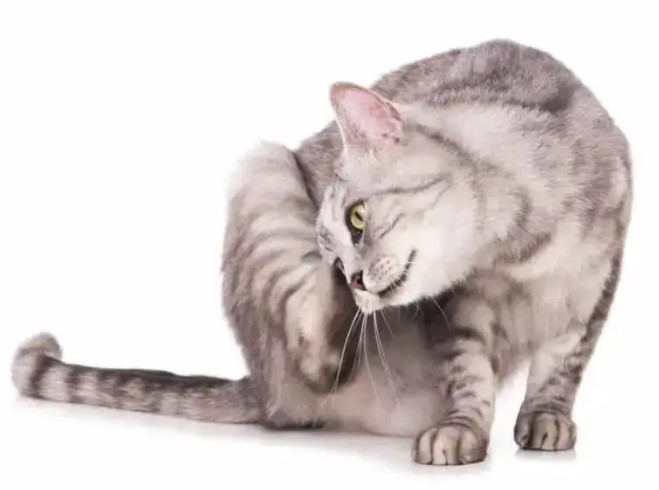Just like humans, cats can also experience hair loss. While it might be due to normal aging or an unnoticed accident, it could also be a symptom of a more serious underlying issue. Fortunately, determining whether a trip to the vet is needed when a bald spot appears is relatively straightforward. If you notice a small patch of fur missing without any signs of blood, pus, or irritation, it might be because your cat scratched vigorously or rubbed against a rough surface, which cats tend to do. Keep a close eye on the patch, and if you don’t see hair regrowing within a week, notice changes in its size or appearance, observe signs of irritation in your cat, or spot additional bald patches, it’s time to consult the vet. We consulted PetCareRx’s vet-verified information to provide you with five potential reasons for your cat’s hair loss.
Hair Loss Culprit #1: Fleas
Some cats are allergic to the saliva left behind by flea bites, a condition known as flea allergy dermatitis. While a cat infested with fleas will show typical signs of extreme discomfort, excessive itching, and grooming, a cat allergic to these unwelcome pests may also experience patchy hair loss, revealing raw and irritated skin, especially around the neck and face. It’s important to note that this allergic reaction can persist for up to two weeks after the fleas are eradicated. According to WebMD Pets, your veterinarian will recommend topical, oral, or injected medications to alleviate your pet’s itching and inflammation. Year-round treatment with flea prevention medication is also recommended to prevent future reactions. However, it’s equally crucial to treat your home by cleaning carpets, bedding, furniture, and other potential flea breeding grounds.
Hair Loss Culprit #2: Environmental or Food Allergies
Hair loss in your cat might be attributed to environmental or food allergies. In fact, PetCareRx identifies this as the leading cause of hair loss, often manifesting as irritated patches of exposed skin. The most accurate way to determine your cat’s allergy is through veterinary tests and recommendations. However, you can also experiment by altering their diet or removing potential allergens from their environment. Sometimes, allergies can be triggered by gluten, grains, or specific proteins. It’s essential to have your cat evaluated by a vet to identify the root cause. If food allergies are to blame, numerous specialty foods, such as limited-ingredient formulas, are available to help your cat recover.
Hair Loss Culprit #3: Ringworm
Ringworm is a fungal infection that can lead to hair loss in cats. It’s crucial to address ringworm promptly, as it’s highly contagious to other cats and even humans. In cats with ringworm, older individuals may experience brittle hair that breaks off in patches, while kittens may develop reddish areas on their face, ears, and paw pads, often accompanied by a white or gray crust. If your cat exhibits these signs, consult your vet immediately for confirmation of the diagnosis and appropriate treatment.
Hair Loss Culprit #4: Hyperthyroidism
Hyperthyroidism is a glandular disorder resulting from an excess or shortage of thyroid hormone. Hair loss is just one of several symptoms, so there’s no need to panic at the first sign of it. Typically, hair loss associated with hyperthyroidism appears as brittle, thinning hair that loses its natural luster and sheds excessively when you groom your cat. If you suspect your cat has hyperthyroidism, consult your vet, who can perform blood tests to confirm the diagnosis.
Hair Loss Culprit #5: Psychogenic Dermatitis
Cats suffering from psychogenic dermatitis engage in compulsive self-licking, leading to baldness. The good news is that this behavior is not life-threatening or associated with serious health risks. Nevertheless, it should be a cause for concern, as it may indicate that your cat is stressed or simply bored. If boredom is the issue, use it as an opportunity to engage with and play with your cat daily. If stress is the culprit, you’ll need to identify the source. Did someone move in or out of your home recently, or have you and your cat relocated? Have you rearranged your furniture? Have you introduced a new cat or another animal to the household? Has your daily routine changed? These are just a few of the factors that can stress out a sensitive cat, and solutions aren’t always straightforward.
If you’re struggling to alleviate your cat’s stress, consult your vet about the possibility of behavioral therapy or, in extreme cases, anxiety medication. As always, it’s essential to contact your veterinarian promptly to obtain an accurate diagnosis and help your cat recover.
About the Author
Dana Mack is a freelance writer and copy editor based in Oregon. She holds a degree in multimedia journalism from Columbia College Chicago and enjoys writing about arts, culture, outdoor activities, and more.
This post contains affiliate links. We only recommend products and companies we personally support and love. Clicking on our links may result in a small commission to us, which helps us continue sharing these products and discounts with you. Your support is greatly appreciated!



